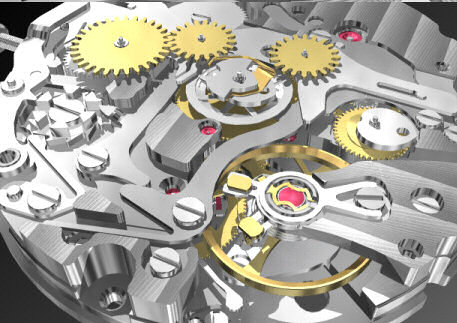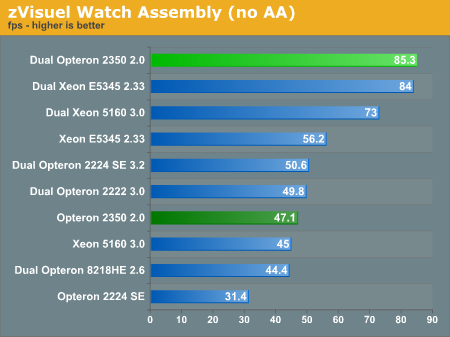AMD's Quad-Core Barcelona: Defending New Territory
by Johan De Gelas on September 10, 2007 12:15 AM EST- Posted in
- IT Computing
Software Rendering: zVisuel (32-bit Windows)
This benchmark is the zVisuel Kribi 3D test, which is exclusive to AnandTech.com and which simulates the assembly of an exclusive mechanical watch. The complete model is very detailed with around 300,000 polygons and a lot of texture, bump, and reflection maps. More than 1000 frames are rendered and the average FPS (frames per second) is reported. All this is rendered on the "Kribi 3D" engine, an ultra-powerful real-time software rendering 3D engine. That all this happens at reasonable speeds is a result of the fact that the newest AMD and Intel architectures contain four cores and can perform up to eight 32-bit FP operations per clock cycle and per core. The people of zVisuel told us that - in reality - the current Core architecture can sustain six FP operations in well optimized loops.

The 3D model of the benchmark in the middle of its assembly
Can the newest AMD architecture sustain the same amount of massive FP power? Eric Bron provided us with a benchmark which is based on real world use by a well know zVisuel client. The first benchmark does not use antialiasing

The tables are turning: while the newest AMD quad-core had to let the faster clocked Intel quad-core Xeon go in the LINPACK tests, it takes a small but still measurable lead in zVisuel. Notice that the Intel CPU has the advantage when it comes to raw processing power: it is about 19% faster in a single CPU configuration. Once you add a second CPU in both systems, that 19% lead is turned into a 3% advantage for AMD. Also note that a 2GHz Quad Opteron 2350 is about as fast as a dual 3GHz Opteron 2222 DC.
Be aware though that you need the Enterprise edition of Windows 2003 to see this kind of performance. The 32-bit Windows 2003 standard does not support NUMA and the bandwidth hungry AMD quad-core does not like that at all. Performance was up to 14% (!) lower, showing only 73 fps instead of 85 fps.

We performed the same benchmark, but with antialiasing applied. AA makes the application a bit more memory intensive. The AMD quad-core extends its lead from 3% to 5%, and a single 2GHz quad-core is now capable of even outperforming a 3.2GHz dual Opteron SE 2224.
The LINPACK and zVisuel benchmarks make it clear that Intel and AMD have about the same raw FP processing power (clock for clock), but that the Barcelona core has the upper hand when the application has to access the memory a lot.
This benchmark is the zVisuel Kribi 3D test, which is exclusive to AnandTech.com and which simulates the assembly of an exclusive mechanical watch. The complete model is very detailed with around 300,000 polygons and a lot of texture, bump, and reflection maps. More than 1000 frames are rendered and the average FPS (frames per second) is reported. All this is rendered on the "Kribi 3D" engine, an ultra-powerful real-time software rendering 3D engine. That all this happens at reasonable speeds is a result of the fact that the newest AMD and Intel architectures contain four cores and can perform up to eight 32-bit FP operations per clock cycle and per core. The people of zVisuel told us that - in reality - the current Core architecture can sustain six FP operations in well optimized loops.

The 3D model of the benchmark in the middle of its assembly
Can the newest AMD architecture sustain the same amount of massive FP power? Eric Bron provided us with a benchmark which is based on real world use by a well know zVisuel client. The first benchmark does not use antialiasing

The tables are turning: while the newest AMD quad-core had to let the faster clocked Intel quad-core Xeon go in the LINPACK tests, it takes a small but still measurable lead in zVisuel. Notice that the Intel CPU has the advantage when it comes to raw processing power: it is about 19% faster in a single CPU configuration. Once you add a second CPU in both systems, that 19% lead is turned into a 3% advantage for AMD. Also note that a 2GHz Quad Opteron 2350 is about as fast as a dual 3GHz Opteron 2222 DC.
Be aware though that you need the Enterprise edition of Windows 2003 to see this kind of performance. The 32-bit Windows 2003 standard does not support NUMA and the bandwidth hungry AMD quad-core does not like that at all. Performance was up to 14% (!) lower, showing only 73 fps instead of 85 fps.

We performed the same benchmark, but with antialiasing applied. AA makes the application a bit more memory intensive. The AMD quad-core extends its lead from 3% to 5%, and a single 2GHz quad-core is now capable of even outperforming a 3.2GHz dual Opteron SE 2224.
The LINPACK and zVisuel benchmarks make it clear that Intel and AMD have about the same raw FP processing power (clock for clock), but that the Barcelona core has the upper hand when the application has to access the memory a lot.










46 Comments
View All Comments
kalyanakrishna - Tuesday, September 11, 2007 - link
I don't deny people use MKL ... I dont agree that anyone targeting performance on AMD Opteron will use MKL. No one running HPL/Linpack for Top 500 submission would use MKL on Opteron. No one who wishes to test his Opteron for performance would use MKL to do so. No one wishing to have the fastest possible results from his Opteron will do so.Even ISV's now provide code that is optimized for Xeon and Opteron separately.
JohanAnandtech - Tuesday, September 11, 2007 - link
Ok, point taken. Give us some time, and we'll follow up with new compilations of Linpack.kalyanakrishna - Wednesday, September 12, 2007 - link
Thank you. Appreciate the effort.leexgx - Monday, September 10, 2007 - link
and how offen do you read anandtechs Previews and reviewsunlike when intels core 2 came out all the hipe was real, to bad for AMD this time
this cpu is going to be good, problem is will it be able to compleat with Intels new cpu when it comes out
i still useing an amd system if your wundering and so all the rest of my pcs apart from my server as i just thow in an old P4 mobo to just file sharein house (all second hand parts apart from the hdds)
phaxmohdem - Monday, September 10, 2007 - link
I wonder if it would be feasible for AMD to take the Intel approach, and slap two of there new native quad cores together and release an octal core CPU in the near future. Or would they remain the multi-core purists they have become... Similarly I wonder if 2 65nm Barecelona cores could even fit under that heat spreader... or come in under an acceptable thermal envelope.Accord99 - Monday, September 10, 2007 - link
It won't fit on Socket F:http://www.madboxpc.com/news/am2/AMD_barcelona.jpg">http://www.madboxpc.com/news/am2/AMD_barcelona.jpg
fic2 - Monday, September 10, 2007 - link
Page 8, 3DS Max 9 last paragraph:"Dual 3GHz Opteron 2222 is capable of generating about 29 frames per hour", but then
"potential 3GHz Barcelona will be able to spit out ~35 frames per second". I think that is supposed to be ~35 frames per hour. Otherwise that is an extremely impressive speedup!
JohanAnandtech - Monday, September 10, 2007 - link
No, it is "per second". We used a Octalcore 2THz Barcelona there.... Thanks, fixed that one :-)
phaxmohdem - Monday, September 10, 2007 - link
Got SuperPi times for that beast? ;)Roy2001 - Monday, September 10, 2007 - link
Kentsfield has 2*143mm^2 dies. Barcelona is 280+ mm^2. Penry would be even smaller, 2*100 mm^2. So unless AMD can increase the frequency to 3.0+Ghz soon and price their new quad-core processors higher than Intel's, AMD would be still in red unless it oursouces Athlon 64 to TSMC.